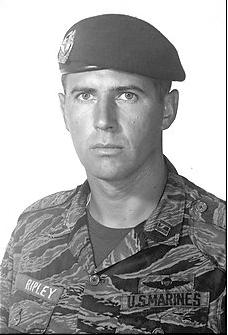
Earlier this week we lost a legend of The Vietnam War. Col. John W. Ripley, USMC (Ret). How much more Fullbore can you get?
John W. Ripley, a highly decorated former colonel who entered Marine Corps lore when he single-handedly blunted a major North Vietnamese offensive during the Vietnam War by blowing up a strategically placed bridge, died Oct. 28 at his home in Annapolis, Md. He was 69.Both the WaPo and NYT do him justice. Read them both.
Colonel Ripley, who at the time was a captain and a military adviser to a South Vietnamese Marine unit, blew up the southern end of the Dong Ha Bridge over the Cua Viet River on Easter Sunday, April 2, 1972. On the north side of the bridge, which was several miles south of the demilitarized zone, some 20,000 North Vietnamese troops and 200 tanks were poised to sweep into Quang Tri Province, which was sparsely defended.
Going back and forth for three hours while under fire, Captain Ripley swung hand over hand along the steel I-beams beneath the bridge, securing himself between girders and placing crates holding a total of 500 pounds of TNT in a diagonal line from one side of the structure to the other. The I-beam wings were just wide enough to form pathways along which he could slide the boxes.
When the boxes were in place on the bridge, Captain Ripley attached blasting caps to detonate the TNT, then connected them with a timed-fuse cord that eventually extended hundreds of feet.
“He had to bite down on the blasting caps to attach them to the fuses,” John Grider Miller, author of “The Bridge at Dong Ha,” said on Monday. “If he bit too low on the blasting cap, it could come loose; if he bit too high, it could blow his head apart.”
Captain Ripley bit safely, and the timed-fuse cord gave him about half an hour to clamber off the bridge. Moments later, his work paid off with a shock wave that tossed him into the air but otherwise left him unharmed.
By placing the crates diagonally along the bridge, Mr. Miller said, Captain Ripley had created “a twisting motion that ripped the bridge apart from its moorings so it couldn’t fall back in place, but collapsed into the river.”
There were about 600 South Vietnamese marines near the south end of the bridge. “South Vietnam would have been in big trouble,” said Fred Schultz, senior editor of Naval History Magazine, a publication of the United States Naval Institute. “The force numbers defending on that side could not have held against that North Vietnamese force.”
The destruction of the bridge created a bottleneck for the North Vietnamese, allowing American bombers to blunt what became known as the Easter offensive.
Captain Ripley was awarded the Navy Cross for his actions at the bridge. He served two tours in Vietnam and remained on active duty until 1992, eventually rising to colonel. Among other decorations, he received the Silver Star, two Bronze Stars and a Purple Heart.
John Walter Ripley was born on June 29, 1939, and grew up in Radford, Va., the son of Bud and Verna Holt Ripley. He enlisted in the Marines out of high school in 1956, and a year later received approval from the secretary of the Navy to attend a preparatory school leading to his appointment to the Naval Academy, from which he graduated in 1962.
Besides his son Stephen, Colonel Ripley is survived by his wife of 44 years, the former Moline Blaylock; a sister, Susan Goodykoontz; two other sons, Thomas and John; a daughter, Mary Ripley; and eight grandchildren.
“Colonel Ripley is well known in marine circles,” Mr. Schultz said, “but he’s the most revered war hero no one’s ever heard of.”
“This was 1972,” he added, “and people didn’t pay too much attention to war heroes at that time.”
Here he is in his own words.
No comments:
Post a Comment